All we ever know for sure about the future is that it will look a lot like the past, only different – or maybe very different, depending on the timescale and interim events. That makes forecasting a black art best left to fortune tellers, charlatans and consultants. But in the same way that weather forecasts often have value in the short term, recent events and past experience can guide reasonable expectations. No warranty express or implied, but herewith the FlightGlobal team’s take on the year to come…
BIG TWINS SQUARE OFF
With Boeing getting its 777X ready for a maiden flight, probably in the first quarter, the twin-aisle market looks set to have an interesting year. Flight testing and certification is expected in time to deliver the first -9 example – 7,600nm (14,075km) range for 400 to 425 passengers – to launch operator Emirates in 2020.
The 777X series – a 350- to 375-seat -8 version will follow – promises to breathe new life into the most successful widebody family ever; all-time 777 orders stand at greater than 1,600 units and the new X variants have already chalked up some 320.
With carbonfibre wings – folding tips, to fit airport infrastructure – and new, GE Aviation GE9X engines, the 777X can perhaps be expected to prove as popular with airlines as the earlier versions; the 777-300ER, with passenger capacity of up to a massive 550 and range of 3,970nm, has seen nearly 800 deliveries owing to its unbeatable economics.
But where Airbus's slightly smaller A330 always trailed its US rival – with fewer than 1,400 all-time orders – its new A350 sits more squarely in 777X payload and range territory – and is proving to be a hit. Total orders for -900 and -1000 variants are approaching 900. Early factory issues seem to be ancient history, so the Rolls-Royce Trent XWB-powered widebody appears to be making healthy progress towards steady-state production.
On top of that, Airbus rolled into the end of 2018 with its updated and re-engined A330-900neo in service. The smaller -800neo had a rougher year, losing launch customer Hawaiian Airlines to Boeing's arch-rival, the 787, but got through its maiden flight in November. And it now has a new launch customer in Kuwait Airways, which looks to take first deliveries in the first half of 2020.
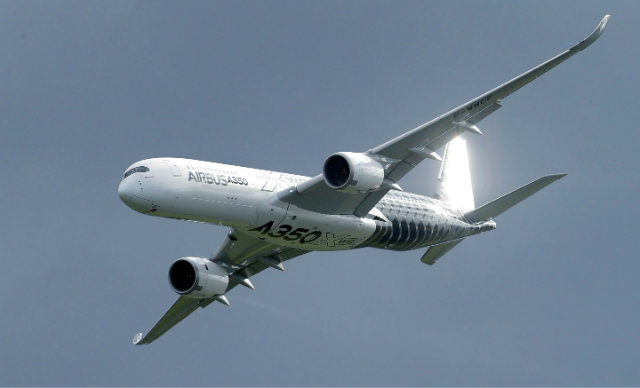
Michael Sohn/AP/REX/Shutterstock
AIRBUS ENTERS THE FAURY ERA
Airbus enters 2019 with a refreshed management team after the largest shake-up of its senior management since the corporate carnage triggered by the A380 production crisis more than a decade ago.
Almost a year after taking over Airbus's backbone commercial aircraft operation, Guillaume Faury (pictured) is preparing to succeed Tom Enders at the helm of a group whose line-up features a new chief operating officer, custodian of aircraft sales and finance head. Airbus's last three years have been characterised by turbulence at production and corporate level and Faury will want to ensure that the airframer regains its stability.
The critical ramp-up of the A350 programme towards its 10-per-month target has progressed smoothly, despite the impact of issues such as the supply problems affecting cabin interiors firm Zodiac. But while the A350-900 has a solid backlog, Airbus will want to address slack order activity for the larger -1000 which, by the end of October 2018, had not secured any significant new sales – other than a virtually dead-on-arrival deal with Iran Air – for more than two-and-a-quarter years.
The overall number of A350-1000s on order actually declined over the period, while rival Boeing recorded orders for 38 777-300ERs, the aircraft against which the -1000 was designed to compete, and edged closer to rolling out its 777X.
Airbus will also aim to jump-start interest in its re-engined A330-800, hoping to catch the wave of A330-200 replacement demand, while pushing its larger -900, newly in service, against the 787. Delivery schedules for 2019 will depend on whether Rolls-Royce overcomes hitches in its supply of Trent 7000 powerplants.
The airframer will be desperate, too, to avoid another year of single-aisle disruption, after the A320neo family's own engine supply problems and the production difficulties encountered with the revamped A321neo – particularly because it faces pressure from a planned ramp-up of output to 60 aircraft per month, its highest-ever rate.
Airbus's ambitious delivery target for 2018 left it, for the third year running, with a daunting production burden in the fourth quarter. Whether or not this exercise in stress management will figure in Airbus's 2019 delivery estimates, the raised single-aisle rates and top of climb for A350 production will be partly offset by plans to limit A330 and A380 output.
Boeing's New Mid-market Airplane threat is likely to drive further enhancements to the A321neo – and potentially to other members of the single-aisle range – given that Airbus has adopted a strategy of pairing the A321neo with the A330neo in a bid to shut out the prospective US rival.
While the backlog for the A320neo family is extraordinarily robust – and is the reason for the rate hike – the single-aisle family has its own weak spots in sales. Four months after taking over the Bombardier CSeries programme and rebranding it as the A220, Airbus had still to demonstrate that it can secure firm orders for the twinjet.
Its own rival to the A220, the yet-to-be-certificated A319neo, remains in limbo – accounting for less than 1% of A320neo-family sales. Airbus is keen to market the A220 but will need to decide the extent to which the A319neo will form part of the future single-aisle line. The A319neo has executive customers, which could spur Airbus to promote a VIP version of the A220.
Faury and his team also inherit the onerous A380 programme, but do so with little or none of their predecessors' attachment to it. While the A380's development was responsible for a period of turmoil among Airbus's leadership, its senior management had remained stable and, at least outwardly, committed to the aircraft since the first delivery more than a decade ago.
Airbus's new executive line-up, then, will be able to take a fresh view of the A380 with a greater degree of detachment, and decide whether the aircraft genuinely has prospects and a place in its portfolio.
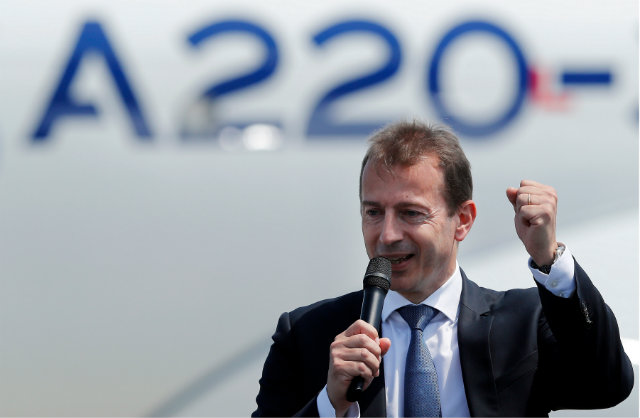
Guillaume Horcajuelo/EPA-EFE/REX/Shutterstock
Airbus A330-800 first flight
November's first flight of the smaller A330neo variant had Airbus whooping with delight. The larger -900 model was by that time ready to begin service, with TAP Air Portugal, but the -800 had been seen as at risk since March 2018, when launch customer Hawaiian Airlines cancelled in favour of the arch-rival Boeing 787. The whole point of the A330neo project, kicked off in 2014, was to a keep pace with the 787 without having to match Boeing's spend – thought to be around $50 billion; Airbus says it spent $2 billion on its re-engined and updated rival.
Certification is expected in mid-2019, with newly signed launch customer Kuwait Airways expected to take first deliveries in the first half of 2020.
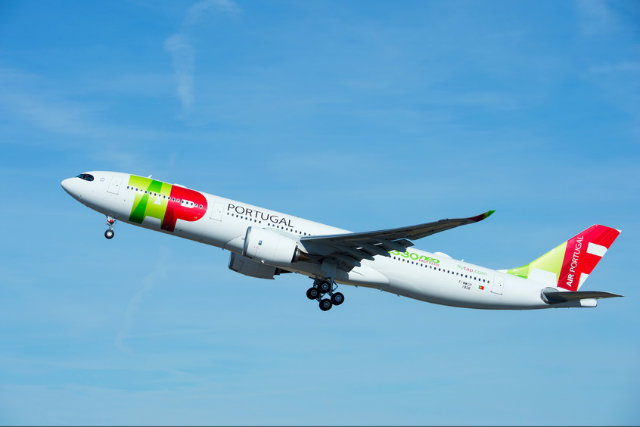
Airbus/A Doumemjou/masterfilms
BOEING EYES CLEAN-SHEETS
Will 2019 be the year Boeing shifts gears in product development? Recent years have seen its commercial aircraft unit take a conservative strategy of updating older aircraft rather than betting big on innovating clean-sheet designs. But Boeing may soon revert back to innovation mode by pulling the trigger on development of an all-new model, provisionally known as the New Mid-market airplane (NMA).
Significantly, Boeing this year expects to acquire Embraer's regional jet business; that deal would further consolidate the aircraft market, check Airbus's advantage in its 2018 acquisition of Bombardier's CSeries – and possibly bolster Boeing's capacity to meet any NMA engineering challenge.
Boeing executives have talked for several years about the NMA, saying they see an opportunity for an aircraft to replace stalwart 767s and 757s. In terms of range and capacity, those aircraft sit between the 737 Max 10 and 787-8, making them uniquely suited for certain long-haul, medium-demand routes, including many across the Atlantic. Boeing has said its NMA would seat 200-270 passengers and have a range of up to 5,000nm (9,260km).
The total sales opportunity remains unclear, but Boeing has produced about 2,170 757s and 767s to date, of which nearly 1,470 remain in service, according to Flight Fleets Analyzer. US carriers American Airlines, Delta Air Lines and United Airlines alone operate nearly 400 of the types.
Though the 767 remains in production, the 120 aircraft on Boeing's books include only military variants and freighters for UPS and FedEx, Fleets Analyzer shows.
Boeing's talk of the NMA has caught the attention of the entire industry, and Boeing's top brass have said repeatedly the company will make a go/no-go decision in 2019. Entry into service would theoretically come around 2025, executives have said.
If Boeing does move forward, also unclear is the degree to which it will push the technological envelope. The company has suggested the NMA could have next-generation engines, a new composite wing and a composite-constructed hybrid cross-section fuselage (a design generally thought to mean an aircraft with a wider passenger cabin and narrower cargo bay).
All that new design work might come a lot more easily should Boeing successfully close its planned acquisition of Embraer's commercial unit. That deal, announced in July, would give Boeing control over Embraer's enormously successful E-Jet programme – a competitive weapon against Airbus's A220.
But analysts have also suggested Boeing's attraction to Embraer rests largely on its widely-respected army of engineers, who could possibly be put to work on Boeing's next aircraft project. The deal would see Boeing acquire 80% of "all aspects" of Embraer's commercial division – meaning aircraft design, manufacturing, certification and sales. The Brazilian company would retain the remaining 20% of the commercial unit, which Boeing has valued at $4.75 billion.
The deal still requires regulatory approval and faces a legal challenge in the form of a class-action lawsuit in a federal court. That court issued an order blocking the deal in early December, though an appeals court quickly overturned the order, putting the deal back on track. Embraer and Boeing have said they expect to close the agreement by the end of 2019.
As if Boeing does not have enough to keep it busy, in 2019 the company also faces pressure to progress with 777X development. The company aims for its GE Aviation GE9X-powered 777-9 flight-test aircraft to achieve first flight during the year, putting it on track to begin deliveries in 2020.
And 2019 will also see a push to repair supply-chain issues that have hobbled 737 production. Boeing struggled last year to meet its goal of producing 52 737s per month amid supply-chain shortages – notably those involving fuselage maker Spirit AeroSystems and engine maker CFM International. Boeing intends to boost production again to 57 737s per month in 2019.
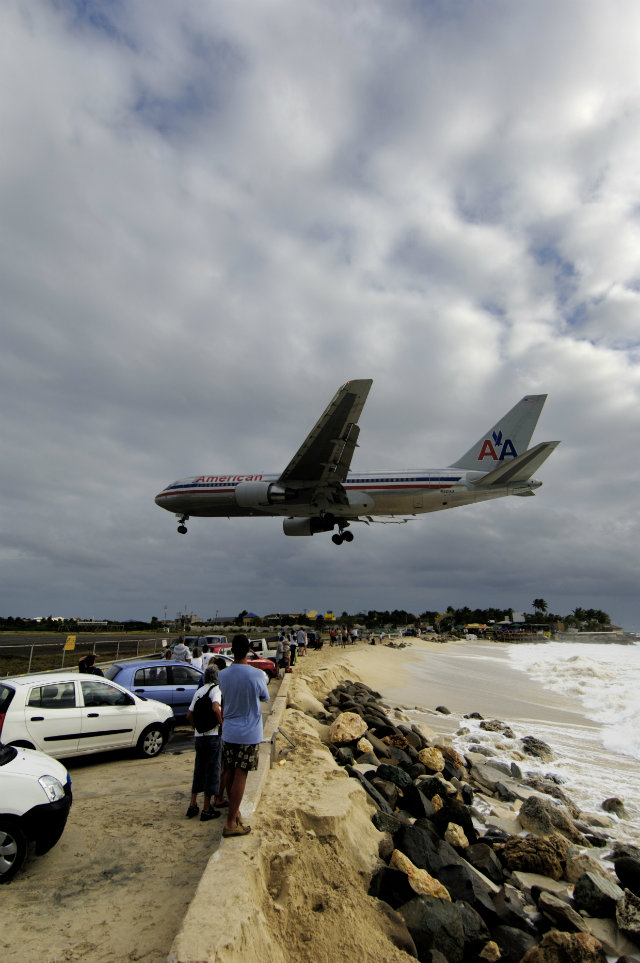
Boeing 767
Aviation Images/REX/Shutterstock
WHAT NEXT BOMBARDIER?
Not too many years ago, Bombardier was a regional aircraft powerhouse, churning out hundreds of jets and a popular turboprop. But the word linked to Canada's aerospace champion today is retrenchment – and it could end 2019 focused solely on business jets.
Following the sale to Airbus of its CSeries narrowbody programme and the November 2018 revelation that the Dash 8/Q400 turboprop programme would be sold to Viking Air, maker of the Twin Otter utility aircraft, the question hanging over Bombardier is, what will happen to the CRJ regional jets? The Q400 announcement included the statement that Bombardier was considering its CRJ "strategic options", so no-one should be surprised if that programme, too, is hived off.
To appreciate the context, consider events dating back to at least 2007. At that time, with the CRJ programme facing immense competitive pressure from Embraer's E-Jet, Bombardier committed its commercial aircraft future to CSeries. But development delays, financial struggles, government cash infusions and a trade battle with Boeing led it to raise the white flag and hand to Airbus control of the CSeries – regarded in every measure but orders as successful.
Meanwhile, the CRJs are years overdue for a major update and orders have fallen off; the backlog stands at about 53 aircraft, with deliveries scheduled to run until the end of 2020. And, said chief executive Alain Bellemare recently, each time a CRJ rolls off the assembly line, Bombardier actually loses money.
Some observers expect Bombardier will sell the CRJ, perhaps to a company like Mitsubishi Aircraft – whose efforts to develop its own MRJ regional jet might value Bombardier's engineering expertise and CRJ global support network.
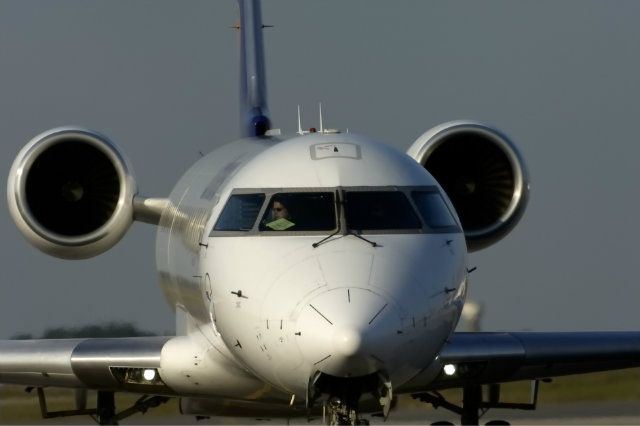
CRJ-700
Aviation Images/REX/Shutterstock
ORDERS OUTLOOK
For any operator or lessor in a rush to acquire new aircraft, there are now only a very limited number of "open slots" available in the next five years and the firm orders backlog continues at record levels of over 14,000 jets. Perhaps not surprising, given the long lead times, there appears to be some slowdown in the rate of new order intake.
However, both Airbus and Boeing want to raise A320neo and 737 Max production rates in the early 2020s, to create open slots so every new customer does not have to wait until 2023. Any higher production rate will depend both on demand, which remains strong, but perhaps more importantly on whether the supply chain can ramp up as well.
More immediately, with the aircraft formerly known as the Bombardier CSeries now in the Airbus fold as the A220, it will be interesting to see how the Airbus marketing machine fares in gaining new orders.
The twin-aisle sector also has very few slots available in the next five years for most programmes – the popular 787 and A350 should both reach their planned production rates in 2019. Boeing appears to be aggressively using its 787 rate increase to target A330neo and A350 customers.
Talks in 2019-2020 between airlines and pilots' unions will have implications for the Embraer E2 and Mitsubishi MRJ programmes. A relaxation of scope clause restrictions, which aim to protect pilots' jobs by preventing airlines from farming out flights on bigger jets to regional subsidiaries with lower salaries, would be a boost for the 90-seat variants. Relaxation would help Mitsubishi sell MRJ90s – prospective launch customers for the smaller MRJ70 variant are, so far, keeping quiet.
Embraer, meanwhile, continues to gain orders for its current E175 from the US market, where its focus is on replacing older 70-seaters with E175s and Bombardier CRJ900s in 70-seat layouts. It will hope to gain traction for the E-Jet E2 programme, with the E195 E2 due in service.
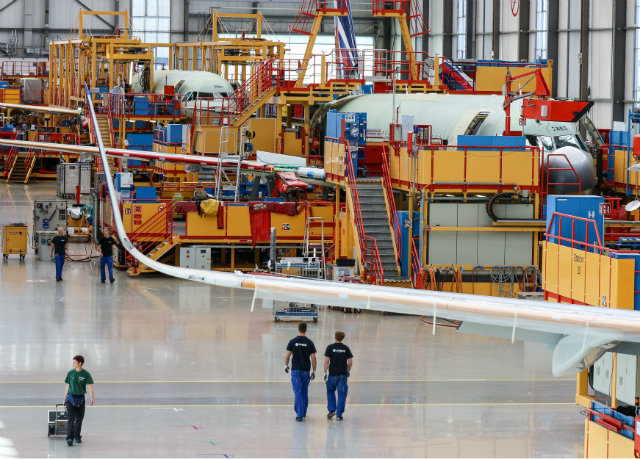
A320 assembly
Focke Strangmann/EPA/REX/Shutterstock
AEROSPACE AND DEFENCE INDUSTRY FEELING FLUSH
In the problems you would like to have department, "too much money" must be near the top of the list. But companies finding themselves in that position are faced with a genuine dilemma; shareholders naturally start to expect that cash which cannot be sensibly invested in the business should be returned to them.
That is exactly what happened to US aerospace and defence companies following the 2011 Budget Control Act, designed to keep the federal debt in check by capping spending and having the effect of contributing to political gridlock in Washington DC and discouraging investment by military equipment manufacturers who, looking ahead, saw no prospect of rising defence budgets.
Companies thus started returning cash to shareholders – who were delighted until they started to ask, in around 2015, where growth might be coming from. The industry, notes Scott Thompson, national leader for the aerospace and defence practice at consultancy PwC, started spending for growth during the tail end of the Obama era, but it was the advent of the Trump administration in early 2017 that really changed the dynamics.
Under Trump, military spending jumped by one-fifth. Then came the 2017 tax cuts. The result is that the US defence industry is flush with cash; investors are still enjoying dividends, but research and development (R&D) spending is up, too.
Thompson reckons it is too early to be sure, as Trump's tax reforms are not yet a year old, but he expects the growth in R&D spending will be modest.
Another natural outlet for spare cash is mergers and acquisitions (M&A). Here, too, the cash effect might be modest. Three of the past four years have seen record M&A activity, says Thompson, and companies are still hungry to buy other companies that can fill gaps in their technology portfolios or to consolidate their positions in the industry. United Technologies' $30 billion acquisition of Rockwell Collins, closed in November, is the biggest recent example.
But Thompson reckons M&A activity will slow down this year. Not, he says, because there is any less hunger for deals, but because of a lack of opportunities. Entering an M&A desert would point companies towards ramping up R&D spending with a view to developing the technologies that will line them up for growth and profit in the future. Unfortunately, those technologies are hard to identify and the sort of cutting-edge work – more R than D – that realises them is slow, expensive and often fails.
Another outlet for cash is investment in the ongoing digital transformation of products, operations and the corporate back office. But, again, some of that work – in artificial intelligence, say – is slow, expensive and risky.
Late 2018 signs from Washington confounded expectations by hinting at continued big defence spending. Hence, shareholders in the big aerospace and defence companies may find themselves continuing to look for ways to spend spare cash – perhaps as dividends and share buy-backs.

Manuel Balce Ceneta/AP/REX/Shutterstock
ALL EYES ON J-20, FC-31 AND H-20 PROGRAMMES
The coming year will offer more glimpses of People's Liberation Army Air Force programmes, with an emphasis on advanced capabilities. While the Chengdu J-20 made a confident appearance at Airshow China Zhuhai in late 2018, with four examples appearing in the flying display, the story of this aircraft is far from over.
The examples flying at the show were likely powered by Russia's Saturn AL-31 engine, but the type's future power will come from the Shenyang WS-15. Although the WS-15 has been in development for years, underlining Beijing's challenges with engines, there are signs of growing confidence.
That confidence was on display at Zhuhai, where state manufacturer AVIC surprised the industry by flying a J-10B (pictured) powered by the local WS-10 fitted with a thrust vectoring control (TVC). The aircraft put on an impressive display, with TVC enabling high angles of attack and impressive manoeuvres such as the falling leaf. Only a handful of elite aircraft use TVC, including the Lockheed Martin F-22, Sukhoi Su-30MKI, and Su-35.
More than ever, China watchers will keep scrutinising new J-20 images for any hint of progress with indigenous powerplants. Longer term, expert speculation suggests the J-20 will truly come into its own with WS-15 engines equipped with TVC.
The year could also see more clarity around the prospects for the Shenyang FC-31. For the past few years this aircraft has been viewed as a programme that evinced little interest from Beijing. There are signs that it could be destined for the decks of future aircraft carriers operated by the People's Liberation Army Navy.
The biggest defence story that could come from China in 2019, however, is the possible emergence of the Xian H-20, a developmental stealth bomber apparently resembling the Northrop Grumman B-2.
Beijing's successful development of a stealth bomber capability would underline its technical prowess and complicate the strategic calculations of rivals. Still, while Beijing is clearly ambitious in many aerospace areas, developing advanced systems is extremely expensive.
What, from the outside at least, appears to be Beijing's smooth march to technological eminence, is more likely a rocky road characterised by the technical and financial problems familiar to advanced programmes in the West.
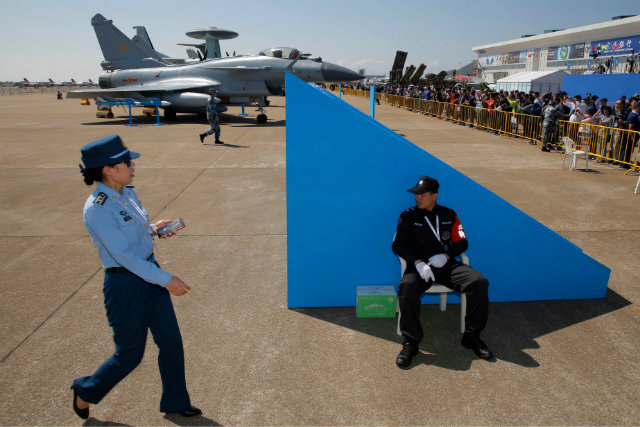
Kin Cheung/AP/REX/Shutterstock
US ARMY EYES ATTACK FUTURE
With light military helicopter manufacturers bracing for years of declining orders, the US Army’s Future Attack Reconnaissance Aircraft request for proposals, released in October, comes at just the right time. The service is looking for a scouting and light attack helicopter to replace the Bell OH-58 Kiowa, a military variant of the Model 206A JetRanger, which was retired in 2017. And the army plans to move quickly.
Fiscal year 2019 should see funding for further development of four to six proposed conceptual designs and approaches. Then, competitors will have about nine months to develop preliminary designs and provide the government with data and insight required to select two companies or teams for the next competitive phase.
The two companies or teams selected will proceed to detailed design, build and test phases. Prototypes are expected to fly in the first quarter of 2023, with a fly-off competition planned between the contending aircraft for the fourth quarter of that year. The army aims to select a winning rotorcraft and transition to a programme of record in 2024, with initial operational capability by 2028; production could run to 500 aircraft.
Worldwide light military helicopter production is projected by Forecast International to shrink by more than 56% to just 92 units a year in 2026, compared with the previous decade, so prototyping and production contracts from the US Army will be especially dear to manufacturers.
Production for the FARA programme will be worth an estimated $2.1 billion by 2032, representing 8.8% of the light military helicopter market by value and 7.3% of the market by unit production, again according to Forecast International. And production for the programme is expected to continue well beyond 2032.
At this time, Sikorsky's S-97 Raider (pictured), a co-axial compound helicopter, is the only clean-sheet aircraft from a US manufacturer to have the flight hours and performance needed to fulfil the army's requirements and is the clear favourite to win. Rival Bell says it will submit a proposal but has declined to say whether its pitch would be a tiltrotor like the V-280 Valor demonstrator it is flying for the army's Future Vertical Lift programme, or a more traditional helicopter.
The Airbus Helicopters X³ and Leonardo AW609 are also clean-sheet rotorcraft with the flight hours and performance needed to meet the scouting and light attack requirement. However, it is unlikely that the Department of Defense would select a foreign-made aircraft over a US one, especially for a combat role.
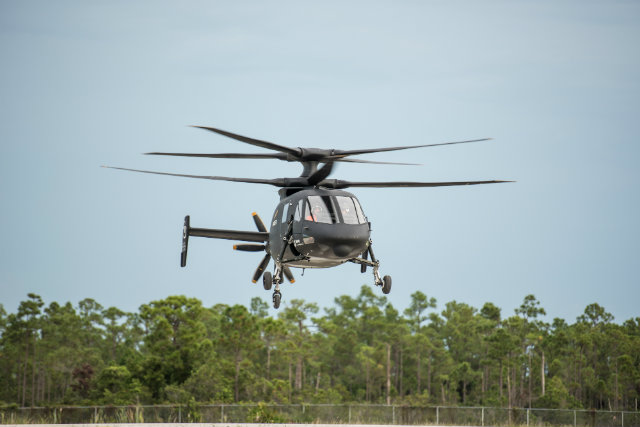
Lockheed Martin
OIL IS BIGGER THAN EVER
Until the last few weeks of 2018 it had appeared that rising fuel costs would provide airlines with the sternest test yet of the robustness of their newfound profitability in the year to come. Even as airlines have shifted to more efficient models amid fleet renewal efforts over recent years, fuel remains airlines' most significant – and notably volatile – cost.
The Brent Crude benchmark price opened 2018 at around $65/barrel along the path of a steady rise that took prices from a range around $50/barrel – that had prevailed before mid-2016 – to a peak of $85/barrel in October 2018. After that came a welcome dip to the low-60s, but the impact of creeping fuel costs across much of the year drove a stream of profits warnings.
For 2019, read volatility. The economics team at Bank of America Merrill Lynch forecasts a 2019 average of $70/barrel – high enough to cause pain for airlines, which in their competitive market cannot easily pass on costs to passengers in the form of higher fares.
But the bank bases its guestimate on "a major shift in US and Iran supply expectations". US supply growth surged in November, and President Trump surprised markets by waiving sanctions against major supplier Iran. In short, $70/barrel assumes generous supply, but there are big risks at play.
One, notes Bank of America Merrill Lynch, is the prospect of a strong US dollar – making dollar-denominated oil pricey for customers living in euros, or sterling. Two, a deterioration of US-China relations hangs a big question- mark over forecasts. Three, shifts in the US-Iran equation could drive prices higher – or lower. And then there is OPEC; cartel members may – or may not – prove co-operative in keeping supplies tight and prices high.
Investors may take some comfort from the still relatively high profit levels among the larger airlines, even when oil prices were heading beyond $80/barrel. IATA expectations are for 2018's collective net profits to be around $4 million on the $38 billion posted in 2017. The 12 months just gone still marks another year of profits above the industry's cost of capital.
However, it seems reasonable to expect casualties among smaller players if there are further sharp rises in fuel prices. Speaking in October to explain his own carrier's falling profits as a function of strikes and high fuel prices, Ryanair boss Michael O'Leary warned that it was "inevitable" that weaker European carriers, especially if not hedged against rising oil prices, would go bust over the winter.
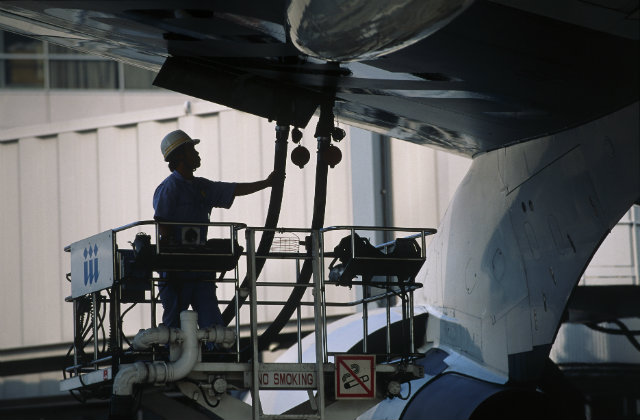
Aviation Images/REX/Shutterstock
DOWN ON THE GROUND
Airport expansion looks likely to impact inter-airline competitive dynamics, with terminals from Santiago de Chile to Panama City in Latin America, and New Orleans to San Francisco in North America due to open. Panama City, and to a lesser extent Santiago – where a new 10-gate international pier will open by year-end – stand out among Latin American airports as building to meet demand.
As Copa Airlines chief executive Pedro Heilbron said in September of the new 20-gate South Terminal at Panama City: "It's more than 50% growth." The project, which has been delayed by about a year, is due to open in early 2019.
At another key hub, Mexico City, conditions will remain tight after a national referendum halted construction in October at a badly-needed new airport. The new Mexican president, Andres Manuel Lopez Obrador, said he will uphold the results, keeping the existing airport and improving two others in the Mexico City area, Toluca and the Santa Lucia military air base.
In the USA, Austin will add nine gates, Dallas/Fort Worth will open a renovated 15-gate satellite for American Airlines, New Orleans its new North Terminal, Phoenix its 15-gate terminal 3 South Concourse and San Francisco the first nine gates of its new terminal 1 boarding area B.
This year, though, is looking like a warm-up. Major projects due to open in 2020 include a new midfield concourse in Los Angeles, a new terminal B headhouse at New York LaGuardia and a new international arrivals facility at Seattle Tacoma.
But the big action may be in China, where Beijing opens a second airport in September. State-owned airlines China Eastern and China Southern will anchor Daxing International (shown under construction), and both plan to base hundreds of aircraft at the new gateway. The two will exploit an easing of Chinese regulations to compete for many destinations with flag carrier Air China, which dominates lucrative long-haul routes out of Beijing Capital International airport.
Daxing, which is about 67km (42 miles) from the current airport and 46km from the city centre, will have the capacity to handle 72 million passengers by 2025 and, eventually, 100 million.

Imaginechina/REX/Shutterstock
NEED FOR SPEED
Already behind China in hypersonic technology and supposedly also trailing Russia, the US military is hoping to make up a lot of ground in 2019. The US Air Force expects an initial operational capability (IOC) in 2020 for its Hypersonic Conventional Strike Weapon (HCSW, pronounced “Hacksaw”) followed in 2021 by IOC for its Air-launched Rapid Response Weapon (ARRW, pronounced “Arrow”). To make those marks, it will need Lockheed Martin, which is developing both hypersonic weapons, to push designs forward rapidly and begin testing.
It was only in April 2018 that the USAF announced a $928 million award to Lockheed Missiles & Space Company to develop HCSW, an air-breathing, ramjet-powered cruise missile. HCSW is intended to be carried on fighter and bomber aircraft and have a precision strike capability against high-value, time-critical fixed and moveable surface targets. In July 2017, the USAF awarded a separate, $780 million contract to Lockheed Martin Missiles and Fire Control to develop ARRW, a boost-glide hypersonic vehicle, which uses a rocket to push its payload to high speeds and high altitudes, before the payload separates from the rocket and glides unpowered to its destination at hypersonic speeds of up to Mach 20.
China and Russia are speeding ahead with hypersonic vehicles and missiles because they view the technology as a means to upset the balance of power with the USA – whose anti-ballistic missile shields would be unable to defend against weapons coming in at Mach 5-plus. Hypersonic vehicles could be used to deliver nuclear or conventional warheads, as well as carry intelligence, surveillance and reconnaissance payloads.
Publicly, China is out front in this new hypersonic race. In August it reportedly conducted the maiden flight of a test vehicle named Starry Sky 2, which boosts its speed by riding on its shockwaves. The vehicle reached Mach 5.5 for more than 6min and has reportedly topped out at M6.
For its part, Russian media reports indicate that the country may have been due to introduce the Avangard hypersonic glide vehicle – supposedly capable of up to M9.1 – into service in late 2018 or early 2019, though defence analysts have expressed doubts about progress on the technology.
The US Department of Defense will aim in 2019 to perfect advanced propulsion systems for its two hypersonic vehicles. Aerojet Rocketdyne has been subcontracted to provide the ARRW booster rockets; for HCSW, the USAF wants proposals for an air-breathing, dual-mode ramjet engine, and plans to award design and test contracts worth a total of $10 million to two companies for competing concepts.
To test much of this cutting-edge technology, including scramjet propulsion, high-temperature-resistant materials and autonomous control systems, the USAF is relying on the X-60A, a hypersonic research rocket formerly known as GOLauncher1 that is being developed by Generation Orbit Launch Services. The X-60A (pictured in a carry test) is an air-dropped liquid-engine rocket designed for hypersonic flight research and its first flight is planned for late 2019.

Generation Orbit
BUSINESS MATTERS
Shorn of its CSeries/A220 and Q400 programmes a slimmed-down Bombardier will be turning its near full attention to its thriving business jets division – and this year will mark the certification and service entry of its new Global 6500 and 5500. Launched in May 2018, the duo are revamped versions of the strong-selling Global 6000 and 5000, featuring Rolls-Royce Pearl 15 engines – for which they are the launch platform – as well as new cabins, avionics and wings.
Bombardier is likely to make a decision in 2019 on whether to proceed with its proposed Global 8000. As things stand the 7,900nm (14,600km)-range aircraft would appear to need a significant range boost to justify development, given the 7,700nm of its Global 7500 stablemate – which boasts the longest cabin in the traditional business aircraft market, at 16.5m (54ft).
The flagship 7500 secured US and Canadian validation in September and November respectively, and Bombardier is now eager to start clearing its 110-strong backlog for the $75 million aircraft. A couple of examples were scheduled for delivery before year-end, and Bombardier hopes to hand over between 15 and 20 units in 2019.
This top-of-the-range model is helping Bombardier to seize the high ground from Gulfstream, which has dominated the ultra-long-range-sector with the 7,500nm G650ER since the type entered service in 2014. The US airframer will not relinquish the top spot readily, so expect its answer to the 7500 over the coming months. The new model could be a stretched version of its all-new G600 and carry the G750 branding.
At Cessna, type certification is expected early this year for its super-midsize Citation Longitude. And Textron Aviation's business aircraft unit will make a go/no-go decision this year on its large-cabin Hemisphere. The programme stalled in early 2018 pending revision of Safran's Silvercrest engine, whose development setbacks led Dassault to axe its 5X programme in late 2017 – leaving the Hemisphere as its sole application.
Testing on Safran's GII flying testbed could be wrapped up in July, when Textron says it will have the data for a go-ahead decision. The Hemisphere programme was given a major boost in October with an order from fractional ownership giant NetJets for up to 150; the record deal also included 175 Longitudes.
Speaking of Dassault, work continues through 2019 on the P&W Canada PW812D-powered 6X (pictured). Launched in early 2018 to replace the 5X, the aircraft maintains its predecessor's tallest-widest cabin appeal; but adds 0.5m to the length; first flight remains on track for 2021, deliveries from 2022.
At the other end of the business aircraft spectrum, Cessna's all-new turboprop pair – the single-engined Denali and SkyCourier twin – are expected to make debut flights in mid-2019 and achieve certification about a year later.
Embraer is meanwhile working hard to bring to market this year its $17 million midsize Praetor 500 and $21 million super-midsize 600; the Honeywell HTF7500E-powered pair were launched in October and promise market-leading range and impressive technology and comfort in increasingly crowded sectors.
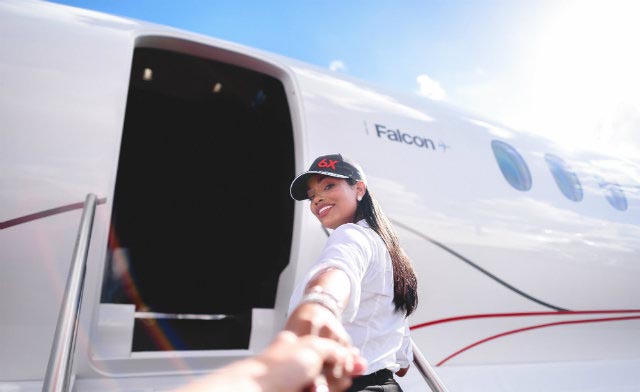
Dassault Aviation/A Marc
US DEFENCE: PROGRAMMES TO WATCH
Boeing KC-46A Pegasus
Still plagued by delays and costs overruns, Boeing's 767 freighter-based KC-46A Pegasus aerial tanker continues to be a headache for the US Air Force. For a few months in 2018, Boeing looked like it would be able to finally put the programme's problems behind it, but seemingly out of habit the company missed its deadline for delivering the first aircraft in October, due to unresolved deficiencies, including with the camera that guides the refuelling boom. Boeing is on contract for the first 52 of an expected 179 tankers for the USAF, and no doubt hopes 2019 will be marked by a succession of rapid deliveries.
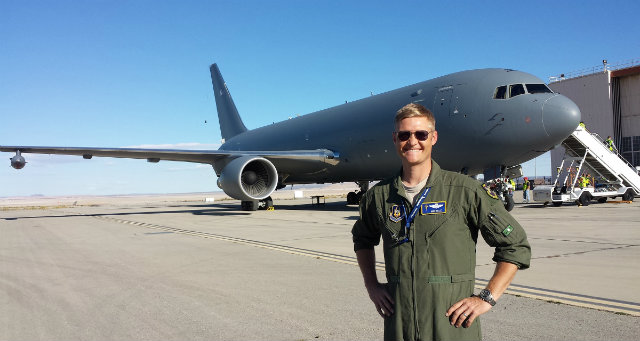
US Air Force
Light Attack and Armed Reconnaissance
With Congress increasingly sceptical of military spending, the defence department might point to its Light Attack and Armed Reconnaissance (OA-X) programme as a money saver. The idea is to use propeller-driven fighters for ground attack and reconnaissance missions where a top-end jet would be overkill. The service has a $300 million budget to procure aircraft and associated long-lead material and intends to award a production contract to Sierra Nevada Corporation or Textron Aviation in the fourth quarter of FY2019.
Northrop Grumman B-21 Raider
Northrop Grumman announced in April 2018 that it had finished the preliminary design review of the B-21 Raider. In December, the secretary of the USAF, Heather Wilson, said the aircraft's developmental review was complete and the bomber remained on schedule. Little else is known about development and delivery, except that the long-range bomber will be fielded in the mid-2020s – and that it is named “Raider”, after the audacious 1942 “Doolittle” raid on Toyko, (North American B-25 Mitchells pictured below, on the USS Hornet). The air force plans to buy 100 B-21s, to retire by 2040 its fleet of 20 Northrop B-2 Spirit stealth bombers and 62 Boeing B-1B Lancers. The USAF has suggested buying dozens of additional stealth bombers, but given budget constraints that is highly unlikely. In 2016, the service said the aircraft would cost $550 million each at 2010 currency values.
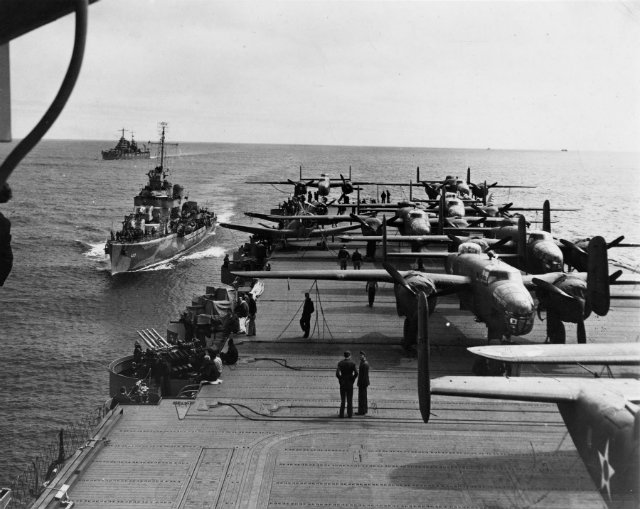
US Air Force
Loyal Wingman
The USAF believes that it does not have enough aircraft to perform the missions the US government asks it to do. So, in addition to asking to grow its squadron numbers by 24%, it is looking to programmes such as the Air Force Research Laboratory (AFRL) Loyal Wingman to fill in the gaps. AFRL has contracted Kratos Defense & Security Solutions to demonstrate that a cheaply built unmanned air vehicle could work alongside advanced fighter aircraft such as the Lockheed Martin F-35 Lightning II to execute a variety of missions – operations that previously would have required an expensive manned aircraft. Kratos expects its XQ-58A Valkyrie unmanned system to make its initial flight by around the end of January 2019.
Future Vertical Lift Medium
The US Army will have two impressive, and technically very different, rotorcraft begging for its attention in 2019: the Bell V-280 tiltrotor and the Sikorsky-Boeing SB-1 Defiant co-axial compound helicopter. The Bell V-280 has been flying for more than a year and the Sikorsky-Boeing SB-1 Defiant was expected to take its first flight in December 2018. Both were built as demonstrators for the army's Future Vertical Lift Capability Set 3 requirement: a medium-sized aircraft to replace the Sikorsky UH-60 Black Hawk and Boeing AH-64 Apache. The army wants an aircraft that can cruise at between 230kt (426km/h) to 310kt with a full payload on missions such as air assault, combat search and rescue and gunship roles; it does not expect initial operational capability until at least 2030, but expect a back-and-forth game of flight demonstrations in 2019.
UNMANNED BUT NOT UNLOVED
Drone Bill
The UK is taking one of the world's most ambitious approaches to the integration of unmanned air vehicles (UAVs) into national airspace and in 2019 it is set to release its new highly anticipated Drone (Regulation) Bill 2017-19 – regulating the purchase and use of unmanned air vehicles weighing 5kg (11lb) or more, which had its first House of Commons reading in 2017, and is expected to have its second on 15 February 2019.
The bill will address policies for the use of UAVs, for appropriate enforcement if they are misused, and will outline minimum age requirements for operators as well as address whether or not the existing 0.5nm (1km) flight restriction around protected aerodromes is sufficient.
It will also respond to a proposal to mandate and regulate a Flight Information and Notification System, as well as outline the powers required by enforcement agencies to effectively police the use of UAVs, including a possible introduction of fixed penalty notices. Counter-UAV technology to protect infrastructure from nefarious use is also being assessed, and the conclusions of this are expected to appear in the bill.
Meanwhile, Civil Aviation Authority amendments to the Air Navigation Order have set an altitude limit of 400ft for all unmanned aircraft – not just those weighing over 7kg as was previously the case. And, operators flying an aircraft weighing between 250g and 20kg now also have to register their UAVs, as well as demonstrate competence.
Nuclear protection
Another 2018 step forward for safety should be some indication of how the UK plans to protect its critical infrastructure from malicious use of UAVs. The UK’s Civil Nuclear Constabulary (CNC) in late September 2018 issued a £400,000 tender calling for implementation of a counter-UAV system.
The system is expected to be operated over a one-year period with options for two further years, calling for a “kinetic effector” system that it says will "physically inhibit a UAV, rendering it non-operational". In plain English, that means shoot it down.
The CNC says UK legislation does not allow use of electronic effectors, which can remotely disable a drone, as there are safety systems at sites that could be inadvertently affected – a restriction that has to be factored into the selected system.
Amazon Prime Air
Has online retail behemoth Amazon gone cold on its much-hyped Prime Air UAV delivery service – or is a big announcement coming soon? News has been sparse at best since a prototype delivered a package during a UK test flight at the end of 2016.
The start of operations was originally touted for 2019, but Amazon has declined to comment on the progress of the project. Watch this space or, perhaps, keep an eye on the sky in your neighbourhood.
But if your neighbourhood is in Finland, you may well see something. Wing, a division of Google parent Alphabet, says it will introduce a UAV delivery service around Helsinki in 2019, following Australian trials over the past 18 months – delivering food, drink, medicine and other household items. Alphabet says if drones can operate in the sometimes-harsh climate of Finland, "they can deliver anywhere!"
From A(irbus) to Z(ephyr)
Airbus Defence & Space rolled into 2019 ready to kick off an ambitious test-flight campaign in Western Australia, where it has formally opened the launch site for its solar-electric, stratospheric UAV, called Zephyr (pictured). Testing last year in Arizona – where Zephyr set a world record for aerial endurance at just minutes short of 26 days – will be followed within the next few months by the first of a series of payload tests that aim to spend much longer periods aloft.
Zephyr – shown in its S iteration at last year's Farnborough air show, and built at a new factory just outside the airfield – has a wingspan of 25m (82ft) but weighs less than 75kg and can maintain daytime altitudes of more than 70,000ft. Critically, the pure-electric aircraft can stay above 50,000ft during the night, so it may never be impaired by weather or air traffic. At Farnborough, Airbus unmanned systems head Jana Rosenmann said the Australia campaign would aim to push endurance limits – which may prove to be as long as 100 day-night cycles without having to land and change batteries.
Stratospheric altitude and extreme endurance place Zephyr in a budding category of craft known as HAPS – or high-altitude pseudo-satellites. Airbus hopes that by going operational soon it will secure solid business in such applications as maritime surveillance, border patrol, forest fire monitoring or even navigation. Another possible use is as a communications relay station – deployable in the wake of a disaster that disables ground infrastructure. HAPS have the advantage over actual satellites of being deployable quickly, with changeable payloads
The first customer is the UK Ministry of Defence, which has ordered three Zephyrs. Airbus hopes its Wyndham trials, which will focus on payloads and endurance, will attract civil customers.

Airbus
VIRGIN ORBIT CARRIES THE CAN
Airlines may be phasing 747s out of passenger service, but one old Queen is starting a second life – giving very special passengers a leg up into space. For Virgin Orbit, the satellite-launching sister company to Richard Branson's Virgin Galactic suborbital tourism venture, an ex-Virgin Atlantic 747-400 named Cosmic Girl is just the trick for lifting its LauncherOne rocket to altitude before dropping it – X-15-style – for ignition and flight to orbit. Aircraft modifications were not extensive, as the concept uses the "fifth engine" carry point that is standard on 747s. November saw the first captive-carry flight of the aircraft-rocket combo (pictured); further trials will culminate in a drop test and, all going well, flight to orbit in early 2019.
LauncherOne is a Virgin Orbit in-house development, with a team working out of design and factory space in Long Beach, near Boeing's now-shut C-17 plant, and test facilities in Mojave. The 33m rocket promises to deliver up to about 500kg to low-Earth orbit.
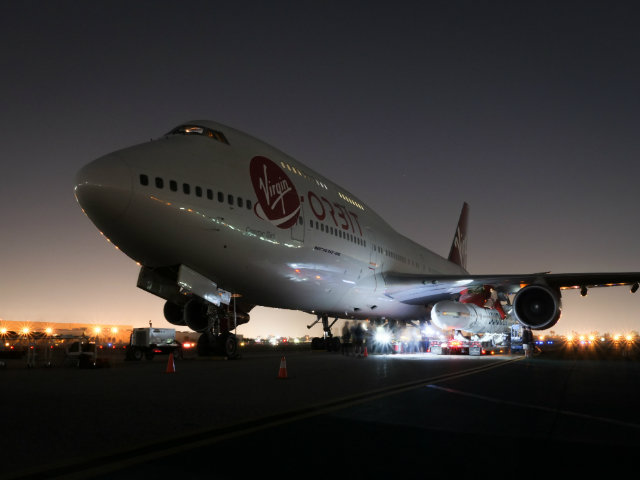
Virgin Orbit
Source: Flight International


























